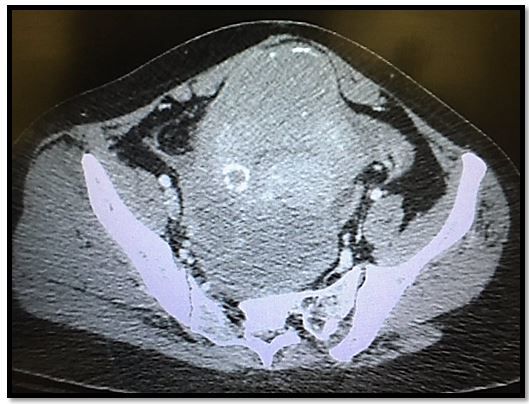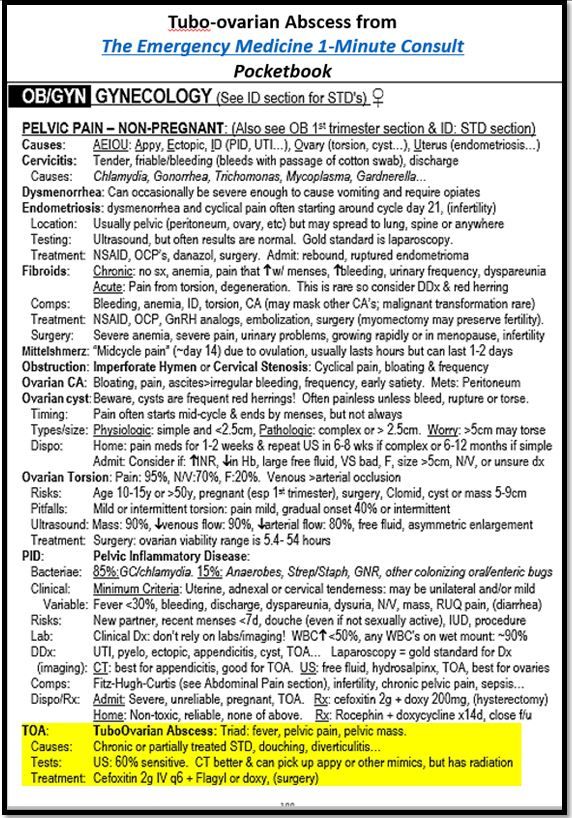- Clinical Technology
- Adult Immunization
- Hepatology
- Pediatric Immunization
- Screening
- Psychiatry
- Allergy
- Women's Health
- Cardiology
- Pediatrics
- Dermatology
- Endocrinology
- Pain Management
- Gastroenterology
- Infectious Disease
- Obesity Medicine
- Rheumatology
- Nephrology
- Neurology
- Pulmonology
Pelvic Pain, Worse When Walking
A 35 y/o woman presents with 3 wks lower abdominal pain that's worse with movement. Review exam, labs, CT scan. Your diagnosis?
Figure 1. (Please click to enlarge)

Figure 2. (Please click to enlarge)

History
A 35-year-old woman with a history of endometriosis and fibroids presents to the emergency department for 3 weeks of lower abdominal pain that suddenly got much worse today around 9 AM. The pain is aggravated by walking or other movement. She denies any fever, vomiting, dysuria, vaginal bleeding, or other complaints
Examination
The patient is noted to be in moderate distress with normal vital signs including her temperature. Examinations of the head and neck as well as the chest are normal. On abdominal exam there is rebound tenderness noted throughout the lower abdomen. Pelvic exam shows no bleeding or discharge.
Tests/Results
• Blood chemistries, LFTs, lipase: normal
• Beta hCG: negative
• CBC: WBC 30,000/uL hemoglobin, 11 g/dL
• ESR: 70 mm/h
• CT scan pelvis: (click on Image to the right to enlarge)
What does the CT image show?
What conditions should be in your differential diagnosis?
Please click below for answers and discussion.
Answers What does the case image show? The CT demonstrates a presacral fluid collection and incidental calcified fibroids. Radiology read: multiple uterine masses which are likely fibroids. Large loculated fluid collection in the cul-de-sac region. This was eventually determined to be a large tubo-ovarian abscess.
What should be in your differential diagnosis? Differential diagnosis should at least include tubo-ovarian abscess, ruptured endometrioma with hemorrhage, and ovarian neoplasm.
Discussion
A tubo-ovarian abscess (TOA) originates from a pelvic infection that spreads from the uterus to the fallopian tube and from there to the ovary and surrounding adnexal structures. It is most typically caused by chlamydia and/or gonorrhea, but can also be caused by normal vaginal flora that infects the uterus, most frequently after douching, or by rupture of a nearby appendicitis, or diverticulitis. Anaerobic bacteriae often play a role as well.
The classic triad of TOA is fever, pelvic pain, and a pelvic mass. Like all infections, a certain percent of patients present without fever on exam or even a history of fever. Lower abdominal, adnexal, and cervical tenderness are usually present on exam.
Testing for TOA usually reveals an elevated WBC count, but like fever, this is not universally present. Traditionally, pelvic ultrasound is recommended as the initial imaging study of choice, but the sensitivity is fairly unimpressive at 60%. CT is actually more sensitive, presumably because it picks up smaller abscesses. In addition, CT also is more likely than ultrasound to pick up other conditions in the differential diagnosis such as appendicitis or diverticulitis.
Treatment of TOA is with antibiotics, with surgery reserved for severe or refractory cases. There are many antibiotic regimens that are effective, but whichever is chosen should cover both anaerobes and sexually transmitted infections. One popular regimen is noted in the highlighted area of the Page Shot to the right.
Case conclusion
Even though there was no fever, the patient was given empiric antibiotics because of the elevated WBC count. She was taken to the OR, where a large tubo-ovarian abscess was diagnosed.
